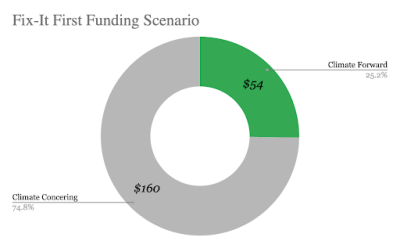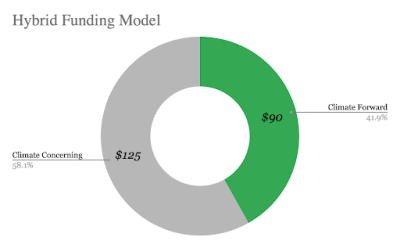By Brett Morgan
While it feels like far longer than just a few months ago when President Biden signed the Federal Infrastructure Bill – also called the Infrastructure Investment and Jobs Act (IIJA) of 2021 – it was the largest single investment in infrastructure in over 40 years, including the largest ever allocations for transit funding and for bridge maintenance and repair. This $1.2 billion bill will help Oregon accomplish a wide variety of desperately needed projects, from aiding the drought-stricken Klamath Basin, to transportation projects, to investments centered on no-carbon energy generation and transmission.
You can’t have quality infrastructure without good land use planning
Land use has a critical connection to infrastructure: our built environment plays a huge role in shaping how we use land and in how future land will be used. Infrastructure is more than just roads and rail lines – it’s water, power, telecommunications, ports and even hospitals to name a few. Water management is critical to the health of our working farms and forestlands, and badly located power transmission technology poses wildfire risks to communities in wildland-urban interface regions – areas where wildfire is more likely to cause damage. Transportation and land use represent two sides of one coin: how we get around our communities plays a direct role in how we develop them, and the demands we place on the land shapes our methods of transportation.
Why is 1000 Friends involved in transportation issues?
We’ve been doing transportation work for almost 50 years – just as long as we’ve been around. Land use and transportation infrastructure are inextricably linked. This is why 1000 Friends, working with Partners in the National Transit Justice Campaign and the Clean Just Transition Network, pushed for including transit funding in the federal transportation bill. We have been directly engaging with public agencies to make sure Oregonians’ voices are being heard in prioritizing the uses of these funds, especially transportation investments. Climate change has unique and broad impacts on land use planning, including agriculture, wildfire, flooding, and many other considerations. This is why addressing climate change through our transportation system is critical, and why land use has a unique role among other policy areas. In Oregon, nearly 45 percent of all greenhouse gas emissions come from the transportation sector. Likewise, the Intergovernmental Panel on Climate Change reports say that the total amount of driving worldwide needs to decrease by 15 percent to meet climate goals, regardless of whether vehicles are gas or electric. With this in mind, land use is a critical tool in meeting Oregon’s climate goals by allowing us to create transportation options that work better for everyone.
What was the process behind the Infrastructure Investment and Jobs Act?
The Oregon Department of Transportation (ODOT) and the Oregon Transportation Commission (OTC) were given broad discretion by the federal government to invest nearly half a billion dollars allocated to Oregon from the bill. In response, these agencies created a public engagement process to hear Oregonians’ priorities on transportation funding. Oregonians overwhelmingly supported options that increased their transportation choices and focused on repairing existing roads – and funding alternatives to roads themselves – rather than expanding them. In partnership with Oregonians, other advocacy organizations, and elected officials from across the state, 1000 Friends worked to create a funding scenario that lined up with Oregon’s values – particularly the need to invest in safe, walkable neighborhoods, downtowns, and school areas across Oregon.
While the OTC didn’t take all of our recommendations, it is also clear that our advocacy helped direct funding towards uses that will lead to safer routes to school, more accessible transportation for the disabled, and transportation safety in every corner of Oregon, and will be built on top of record transit funding from the federal government. Without dedicated organizations working in a coalition, we know the outcome would have not been the same, even if we were hoping for the very best.
The graphs below show how our advocacy worked: gray sections are roadway projects, and green sections are investments in safety, active transportation, and transit – things that promote good land-use patterns. Our efforts helped direct an additional $40+ million to climate forward investments, and we helped secure funding for DLCD transportation planning work that will be critical to long term greenhouse gas reductions in the state.


What comes next
Our work in the transportation space is an ongoing commitment of 1000 Friends. We continue to be a core leader in the Getting There Together Coalition and The Clean Just Transition Network, and are a member of the National Transit Justice Campaign. Our hard work and advocacy as part of these coalitions has helped pass hundreds of millions worth of funding for transportation projects in recent years.
We will continue to advocate for the best use of IIJA funding as more specificity is built into the OTC’s plan, and as projects begin to appear at the local level. Supporting our work is critical to ensure that good land use is reflected in transportation, helping create thriving communities and preserving our working and natural lands.
President Biden’s visit to Portland was underscored by this New York Times article – a lot of our great transportation partners are featured. In addition to the IIJA, additional federal funds are enabling the replacement of the Interstate Bridge and several other projects. This is why even now 1000 Friends is helping form new coalitions, such as the Just Crossing Alliance, to ensure that land use isn’t lost in megaproject discussions. We strongly believe that all transportation users, from cargo drivers to those who rely on public transit, must have their needs met by a replacement bridge.
